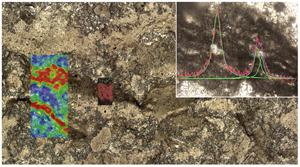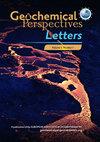新生代硅化叠层石中生物结构的相关微谱分析
IF 3.7
1区 地球科学
Q1 GEOCHEMISTRY & GEOPHYSICS
引用次数: 0
摘要
几十年来,有关古叠层石生物成因的问题一直困扰着地球生物学家。非生物过程可以产生表面上类似叠层石的结构;此外,叠层石经常无法保存其微生物建筑师的有机材料和细胞痕迹。我们利用空间相关的光学和电子显微镜以及拉曼和傅立叶变换红外显微光谱技术,发现托尼时期斯基洛加里白云岩(南澳大利亚弗林德斯山脉)的硅化叠层石含有保存完好的微生物垫碎片和微生物诱导的沉积结构。这些富含有机质的地层呈现出继承度较低的垫状层理,反映了微生物群落与其环境之间的相互作用,即生长、沉积物捕集和结合以及对早期成岩作用的反应,与非生物形成的情况不符。这些角质遗迹虽然只占叠层石体积的一小部分,但显然是合成的,由芳香族和脂肪族有机物组成,很可能是由于早期快速硅化而保存下来的。对这种层状规模特征的起源进行制约,可以阐明形态发生和成岩作用之间的关系,并有助于解决围绕深部时间叠层石生物成因的争议。本文章由计算机程序翻译,如有差异,请以英文原文为准。

Correlative microspectroscopy of biogenic fabrics in Proterozoic silicified stromatolites
Questions surrounding the biogenicity of ancient stromatolites have perplexed geobiologists for decades. Abiotic processes can produce superficially stromatolite-like structures; moreover, stromatolites frequently fail to preserve organic materials and cellular traces of their microbial architects. Using spatially correlated optical and electron microscopy coupled with Raman and FTIR microspectroscopy, we show that silicified stromatolites from the Tonian Skillogalee Dolomite (Flinders Ranges, South Australia) contain exceptionally well preserved microbial mat fragments and microbially induced sedimentary structures. These organic-rich layers exhibit mat-like laminations with low degrees of inheritance and reflect interactions between microbial communities and their environments, i.e. growth, sediment trapping and binding, and reactions to early diagenesis, and are inconsistent with abiotic formation. Although accounting for a minor proportion of the volume of the stromatolites, these kerogenous relics are demonstrably syngenetic and comprise aromatic and aliphatic organic materials, likely preserved due to early and rapid silicification. Constraining the origins of such lamination-scale features can elucidate relationships between morphogenesis and diagenesis and may assist in the resolution of controversies surrounding stromatolite biogenicity in deep time.
求助全文
通过发布文献求助,成功后即可免费获取论文全文。
去求助
来源期刊

Geochemical Perspectives Letters
Earth and Planetary Sciences-Geochemistry and Petrology
CiteScore
7.00
自引率
2.00%
发文量
42
审稿时长
15 weeks
期刊介绍:
Geochemical Perspectives Letters is an open access, internationally peer-reviewed journal of the European Association of Geochemistry (EAG) that publishes short, highest-quality articles spanning geochemical sciences. The journal aims at rapid publication of the most novel research in geochemistry with a focus on outstanding quality, international importance, originality, and stimulating new developments across the vast array of geochemical disciplines.
 求助内容:
求助内容: 应助结果提醒方式:
应助结果提醒方式:


